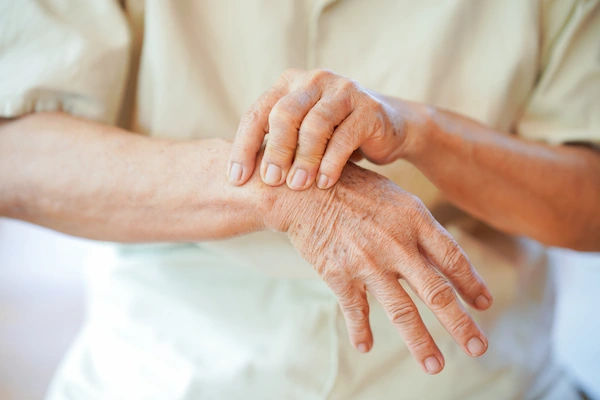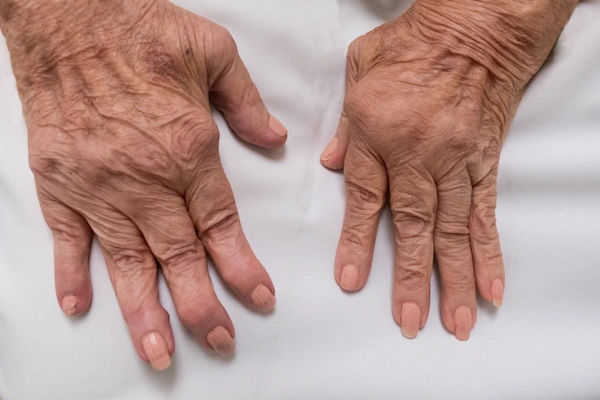Weight Management Guide for Arthritis Prevention
Discover how maintaining a healthy weight can help prevent arthritis, reduce joint strain, and improve overall mobility.


Introduction
Are you concerned about joint pain or have a family history of arthritis? One of the most powerful steps you can take to protect your joints is often overlooked: effective weight management. This isn't just about aesthetics; it's a fundamental pillar of preventive health. Carrying excess weight significantly increases the stress on your joints and can trigger widespread inflammation, two key drivers of arthritis. The good news is that you have more control than you might think. This comprehensive guide will walk you through the undeniable connection between body weight and joint health, providing you with a practical, sustainable blueprint for using weight management as a key strategy for arthritis prevention and management. We'll explore an anti-inflammatory diet, safe and effective exercises, and lifestyle tweaks that together can lighten the load on your joints and pave the way for a more active, pain-free future.
The Critical Link: Understanding How Weight Impacts Your Joints
The relationship between body weight and arthritis, particularly osteoarthritis (OA), is both mechanical and metabolic. It's a classic case of a "double whammy" where excess weight doesn't just add physical stress but also creates a hostile inflammatory environment within the body.
The Mechanics of Pressure: A Simple Equation
Think of your joints as the shock absorbers of your body. With every step you take, a force equivalent to about 1.5 times your body weight travels through your knees. When you run or jump, this force multiplies to four to six times your body weight. Now, consider the math: for every 10 pounds of excess weight you carry, your knees endure an extra 30-60 pounds of pressure with each step. Over thousands of steps per day, this relentless excess load accelerates the breakdown of the protective cartilage that cushions the ends of your bones. This is why weight management is non-negotiable for knee and hip health.
The Chemistry of Inflammation: More Than Just Wear and Tear
The story doesn't end with mechanics. Fat tissue, especially visceral fat stored around the abdomen, is not inert. It's metabolically active, producing proteins called cytokines that promote inflammation throughout the body. This systemic inflammation can affect the lining of the joints, contributing to the pain and swelling characteristic of arthritis. This is particularly relevant for inflammatory types of arthritis like rheumatoid arthritis. Therefore, losing weight isn't just about reducing load; it's about calming the internal fire of inflammation. A study published in Arthritis Research & Therapy found that a 10% reduction in body weight can lead to a significant reduction in inflammatory markers.
Your Dietary Blueprint: An Anti-Inflammatory Approach to Weight Loss
Shifting your diet to focus on anti-inflammatory foods is a winning strategy for both weight management and arthritis prevention. This approach helps you create a calorie deficit for weight loss while simultaneously supplying your body with nutrients that fight inflammation.
Foods to Embrace: Your Arthritis-Fighting Toolkit
- Omega-3 Fatty Acids: These are powerful inflammation fighters. Excellent sources include fatty fish (salmon, mackerel, sardines), flaxseeds, chia seeds, and walnuts.
- Colourful Fruits and Vegetables: Packed with antioxidants and phytochemicals that combat oxidative stress. Berries, leafy greens, oranges, and bell peppers are all stellar choices.
- Whole Grains: Foods like oats, quinoa, and brown rice are high in fibre, which helps with satiety (feeling full) and supports a healthy gut microbiome, linked to reduced inflammation.
- Lean Proteins: Sources like chicken breast, turkey, legumes (beans, lentils), and tofu help preserve muscle mass during weight loss, which is crucial for supporting your joints.
- Healthy Fats: Avocado, olive oil, and nuts provide sustained energy and have anti-inflammatory properties.
Foods to Limit: Inflammatory Culprits to Avoid
- Processed Foods and Sugars: Sugary drinks, pastries, and processed snacks spike blood sugar and promote the release of inflammatory messengers.
- Refined Carbohydrates: White bread, white rice, and pasta can have a similar inflammatory effect as sugar.
- Saturated and Trans Fats: Found in red meat, fried foods, and many packaged baked goods, these fats can increase inflammation.
Practical Portion Control and Mindful Eating Strategies
Adopting an anti-inflammatory diet plan for joint pain doesn't have to be complicated. Use the plate method: fill half your plate with non-starchy vegetables, a quarter with lean protein, and a quarter with whole grains. Practice mindful eating by slowing down, savoring each bite, and listening to your body's hunger and fullness cues. This helps prevent overeating and fosters a healthier relationship with food.
Consult a Dietitian for the best advice
Moving Without Pain: Safe Exercises for Joint Health and Weight Loss
The thought of exercising with joint pain can be daunting, but the right kind of movement is a potent medicine. Regular physical activity is essential for weight management and actually helps lubricate joints and strengthen the surrounding muscles, providing better stability.
Low-Impact Cardio Champions: Swimming, Cycling, and Elliptical
Low-impact workouts for joint health are the cornerstone of an arthritis-friendly fitness routine. They burn calories and improve cardiovascular health without jarring your joints.
- Swimming and Water Aerobics: The buoyancy of water supports your body weight, relieving stress on joints while providing resistance for a full-body workout.
- Cycling (Stationary or Outdoor): Cycling is excellent for building leg strength with minimal impact on your knees and hips.
- Elliptical Trainer: This machine mimics a running motion but with a smooth, gliding action that avoids the high-impact landing of each step.
The Power of Strength Training: Building a Muscular Support System
Strong muscles act like natural shock absorbers for your joints. Focus on strengthening the muscles around key joints like the knees and hips.
Examples: Leg presses, straight-leg raises, and gentle squats (without going too deep) can build quadriceps and glute strength. Even simple bodyweight exercises can be highly effective. If you're new to strength training, consider a session or two with a physical therapist to learn proper form.
Flexibility and Balance: The Role of Yoga and Tai Chi
Activities like yoga and Tai Chi improve flexibility, which helps maintain a full range of motion in your joints. They also enhance balance, reducing the risk of falls that could injure already vulnerable joints. The meditative aspect of these practices also helps manage stress, which is another contributor to inflammation.
Building Sustainable Habits: A Lifestyle for Long-Term Joint Health
Crash diets and intense, unsustainable workout regimens are counterproductive. The goal is to build habits you can maintain for life.
Setting Realistic Goals and Tracking Progress
Aim for slow, steady weight loss of 1-2 pounds per week. This is more likely to be permanent. Instead of focusing solely on the scale, track non-scale victories like having less pain, being able to walk further, or needing less medication. These are powerful motivators.
The Importance of Sleep and Stress Management
Poor sleep and chronic stress can elevate cortisol levels, a hormone that promotes inflammation and can lead to weight gain, particularly around the abdomen. Prioritise 7-9 hours of quality sleep per night and incorporate stress-reduction techniques like deep breathing, meditation, or spending time in nature into your routine.
When to Seek Professional Guidance
While lifestyle changes are powerful, they are most effective when guided by expertise. If you are experiencing persistent joint pain, stiffness, or swelling, it's crucial to get an accurate diagnosis. A healthcare professional can diagnose the type of arthritis, rule out other conditions, and help you create a personalised plan that addresses your specific needs. They may also recommend physical therapy to learn safe exercises or suggest specific tests.
Conclusion
Weight management is arguably the single most impactful modifiable risk factor for preventing and managing arthritis. By understanding the dual mechanical and inflammatory burden of excess weight, you can take proactive, empowered steps toward protecting your joints. This journey is not about drastic deprivation but about embracing a nourishing, anti-inflammatory diet and finding joy in movement that respects your body. The strategies outlined here, from filling your plate with colourful foods to discovering the freedom of water-based exercise, are your toolkit for building a sustainable, joint-friendly lifestyle. Remember, even small, consistent changes can yield significant results, reducing pain, improving mobility, and enhancing your overall quality of life. Start where you are, use what you have, and take that first step today toward a lighter, brighter future for your joints.
Consult a Dietitian for the best advice
Consult a Dietitian for the best advice

Ms. Sushma Jaiswal
Dietician
42 Years • M.Sc.(Food & Nutrition)
Bengaluru
Swasthya Nutrition, Bengaluru

Ms Malabika Datta
Dietician
19 Years • Bsc (Clinical Nutrition & Dietetics), Msc (Dietetics & Food Service Management)
Kolkata
Malabika’s Diet Clinic, Kolkata

Dr Darshana R
General Physician/ Internal Medicine Specialist
15 Years • MBBS, MD, DNB (Internal Medicine), Diploma in Allergy, Asthma and Immunology , Fellowship in Diabetes
Bengaluru
Apollo Clinic, JP nagar, Bengaluru

Neelanjana J
clinical nutrition
3 Years • Bsc., Msc. Nutrition and Dietetics.
Bengaluru
Apollo Clinic, JP nagar, Bengaluru
Ms Chetu Singhi
Dietician
20 Years • MSC Dietetics & Nutrition
Kolkata
RB Diagnostic - Dietician Diet2fit Chetu Singhi, Kolkata
Consult a Dietitian for the best advice

Ms. Sushma Jaiswal
Dietician
42 Years • M.Sc.(Food & Nutrition)
Bengaluru
Swasthya Nutrition, Bengaluru

Ms Malabika Datta
Dietician
19 Years • Bsc (Clinical Nutrition & Dietetics), Msc (Dietetics & Food Service Management)
Kolkata
Malabika’s Diet Clinic, Kolkata

Dr Darshana R
General Physician/ Internal Medicine Specialist
15 Years • MBBS, MD, DNB (Internal Medicine), Diploma in Allergy, Asthma and Immunology , Fellowship in Diabetes
Bengaluru
Apollo Clinic, JP nagar, Bengaluru

Neelanjana J
clinical nutrition
3 Years • Bsc., Msc. Nutrition and Dietetics.
Bengaluru
Apollo Clinic, JP nagar, Bengaluru
Ms Chetu Singhi
Dietician
20 Years • MSC Dietetics & Nutrition
Kolkata
RB Diagnostic - Dietician Diet2fit Chetu Singhi, Kolkata
More articles from Arthritis
Frequently Asked Questions
I have knee arthritis and find it painful to exercise. Where should I start?
Start with the lowest-impact options available. Water aerobics or simply walking in a pool is excellent because the water supports your body weight. A stationary bike, set with minimal resistance, is also a great starting point to build strength without impact.
Is there a specific 'arthritis diet' I should follow?
There is no one-size-fits-all diet, but the Mediterranean diet is widely recommended by experts for arthritis prevention. It emphasises fruits, vegetables, whole grains, fish, and healthy fats, all aligned with an anti-inflammatory approach to weight management.
How much weight do I need to lose to see a difference in my arthritis pain?
Research shows that losing as little as 5% of your body weight can lead to a noticeable reduction in joint pain and improved function. For a 200-pound person, that's just 10 pounds.
Are there any supplements that help with weight loss and arthritis?
While a balanced diet should be your primary focus, some supplements like Omega-3 fish oil have strong evidence for reducing inflammation. However, always consult your doctor before starting any new supplement, especially if you are on medication.
Can losing weight cure my arthritis?
While weight loss cannot reverse existing structural damage to cartilage (a cure), it is one of the most effective ways to manage symptoms, slow disease progression, and prevent further joint damage. It can lead to a dramatic reduction in pain and a significant improvement in quality of life.




